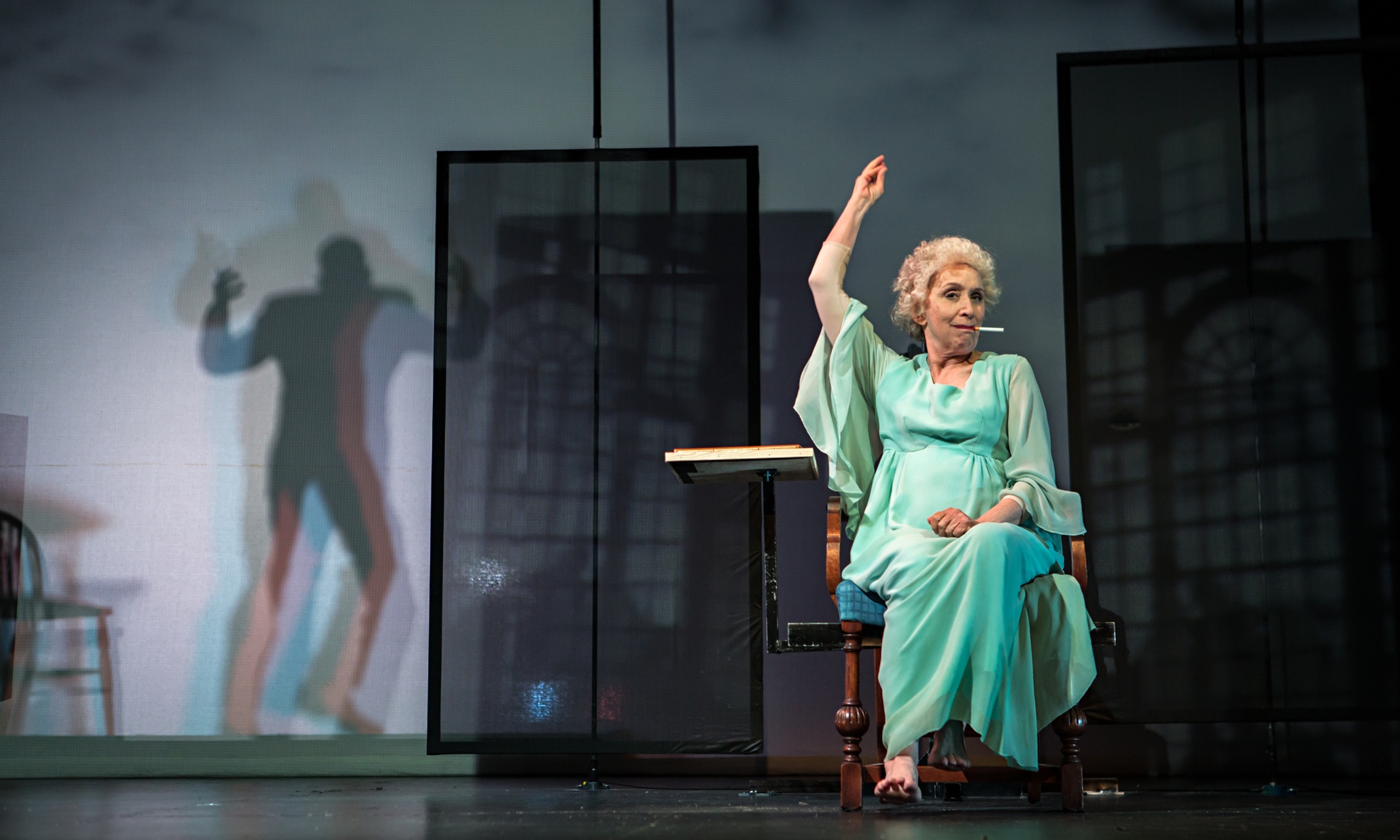‘Bad news – I’m dead.’ says Lucia Joyce.
Viewed by the world as the mad daughter of the genius writer James Joyce, Lucia is here to tell us her version of her life story, as we watch her moving from earthly existence to afterlife – a true bardo of becoming.
The scenography of the piece is stunning (this is the legendary Mabou Mines, so no surprises there). Lucia, dressed in a duck-egg-blue wafty-sleeved negligee, is seated centre-stage on a large chair, which has a long metal attachment coming out of the back, manipulated by a man in puppeteer blacks and hood, the chair moving up and down and side to side, like a strange cross between a visit to the dentist and a fairground ride. As she speaks of dancing in Paris with Isadora Duncan’s brother Duncan, and falling in love with Samuel Beckett and Alexander Calder, she soars and flies. ‘I was born to dance’ she says, and a crackly recording of I’m Forever Blowing Bubbles plays. She remembers Ireland too – balmy Bray where she kissed a priest and kicked a nun. She was always happy to sit on Ezra Pound’s knee, we learn.
At other points in the piece, the chair is still, and as she speaks of the more troubling aspects of her life – her fights with her mother, the commitment to institutions, the medical investigations and medications – the shadow of a man is seen sitting behind her taking notes. Who is this man, and what does he want of me, she wonders. As she talks, she both demonstrates and explains her strange way with the English language – one of four languages she speaks fluently – which often follows its own trains of thought. ‘Insex – incest – insects’ is one; and, ‘I’d like to be buried not incriminated,’ she announces at another point. Her immediate experience of death is that it is boring. ‘When will it end?’ she says, looking around at the same old hospital room she has been stuck in for so many years whilst alive. Now she’s dead she’s hoping for something better. But for now, she could really do with a cigarette…
The back wall upstage has a number of frames that can revolve, and as still images are projected over the whole stage a kind of 3D video-mapping effect is created. The film imagery echoes the references Lucia makes to cities lived in or visited: Paris, Zurich, Dublin – although often not the glorious sights that she is remembering but the insides of the institutions she has been confined in. Now, we learn, she is in somewhere called St Andrews. She’s been here for 40 years, and now it’s time to go. But who will come to collect her?
The answer, inevitably, is that it will be her father James Joyce. As her body seemingly grows more transparent by the minute (more clever video-mapping as images of Arcadian idylls merge her with the background) she is joined onstage by a debonair man in a cream linen suit and Panama hat. By now, we’ve heard how he had her locked away, spent visiting time with her taking copious notes, then using her portmanteau language as his inspiration in Finnegan’s Wake. But that’s all forgiven and forgotten as the strains of You’re the Cream in My Coffee kick in, and she is united once again with her dear father. All is milk and honey.
Shadowy manly appearances aside, this is mostly a one-woman show delivered with extraordinary skill. It is written and directed by Sharon Fogarty, co-artistic director of Mabou Mines; with Maria Tucci, a very talented actor tackling this meaty role with gusto, as Lucia Joyce; and Paul Kandel as James Joyce, playing his supporting role with panache. The lift-chair is a great device for literal and metaphorical flying, and the visuals are gorgeous. The lighting design is innovative, with the tiny side-lamps in this red plush theatre used cleverly. It is, in essence, a text-based piece with a beautiful design, rather than a piece of visual theatre – the storytelling is carried by the words, and everything else is for the most part illustrative (in the best possible way).
The title of the show refers to the writings that Lucia left behind – usually only of interest to Joyce scholars, used to fill in biographical detail of his life. The play is many things – a harrowing portrait of what it is to be the child of a famous artist, an indictment of the terrible waste of life brought about by incarceration in mental hospitals (she was locked up for 47 years, despite at least one medical opinion stating that she was ‘neurotic not lunatic’), and a criticism of her family – James Joyce in his use of his daughter’s way with words as material to plunder, Nora for her jealous oppression of her daughter’s enthusiasms, and brother Giorgio for his role in having her locked up at the age of 28.
But more than any of those things, it is a joyous celebration of Lucia Joyce, as envisioned by Fogarty – a chain-smoking life-loving multi-lingual dancing girl whose wings were clipped at a tragically young age.

